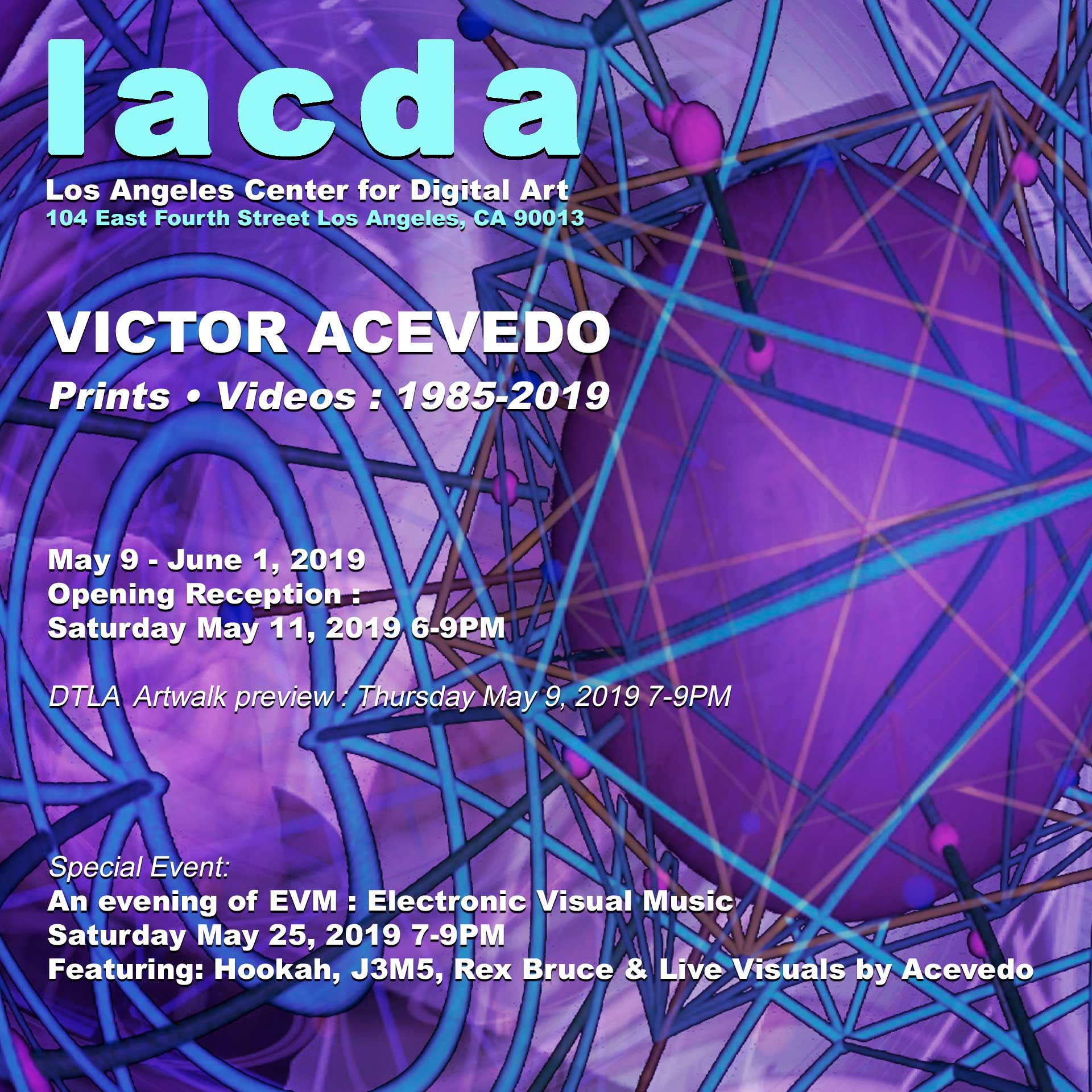


Victor Acevedo
Prints & Videos : Selected works : 1985-2019May 9-June 1, 2019
Reception: Saturday, May 11, 6-9pm
Artwalk preview: Thursday, May 9, 7-9pm
Victor Acevedo is an artist best known for his digital work involving printmaking and photography. However, since 2007 his primary focus has been on video and producing visual music works. As an ongoing practice, he selects still images from the videos and makes them available as signed limited edition prints.
Acevedo is considered a desktop computer art pioneer as he was an early adopter of pre-Windows personal computers (IBM PC) to create fine art in the early 1980s. He now works primarily on the Apple OS platform. In 2012 Acevedo began using the software called VDMX to integrate real-time video work-flows into his audio-visual (AV) studio practice.
He attended Art Center College of Design (Pasadena) majoring in Fine Art (1979-82) and later went on to teach at the School of Visual Arts in New York, in the BFA and MFA computer art departments (1997-2008.)
Acevedo has shown his work in over 125 group and solo art exhibitions in the U.S. and Internationally since 1982. His work has been featured in many (digital) art history books; most notably “Moving Innovation: A History of Computer Animation” (Tom Sito, MIT Press, 2013); “From Technological to Virtual Art” (Frank Popper, MIT Press 2007); “Art of the Digital Age” (Bruce Wands, Thames and Hudson, 2006.) His early geometrical ‘surrealist’ analogue media paintings and drawings were discussed in detail in “Escher’s Legacy: A Centennial Celebration” (Doris Schattschneider & Michelle Emmer eds., Springer-Verlag 2002)
Detailed Background:
Exploring the (perceptual) implications of synesthesia* and cymatics as well as polyhedral geometry based on R. Buckminster Fuller’s Synergetics, Acevedo’s recent work investigates the intersection of electronic music, jazz and audio synthesis as in drone works or glitch/harmonic noise, with dynamic geometrical structure.
* This is ‘synesthetic’ phenomena only as referred to and implied by the tight-sync of motion graphic elements with sonic events on the video time-line.
Analog to Digital Art
The arc of Acevedo’s career is noteworthy in that it begins in his student phase in 1977 with traditional (analog) media painting and drawing and then transformed starting in 1983 to exclusively digital media.
To date, the 3 main periods of Victor Acevedo’s work are as follows:
1977- 87: Analog Art: traditional media, painting, drawing & film
1983 to 2007: Digital Art: archival ink jet and photo prints
2007 to present: Visual Music: Digital Video and Digital PrintsEarly Influences
Acevedo’s key early influences were Cezanne, Picasso, M.C. Escher, Salvador Dali and Buckminster Fuller. A deep study of their work and ideas, led him to the genesis of his space-frame & polyhedral graphical metaphor. It is a kind of ‘geometrical Surrealism’ and it is quite evident in his early traditional media work. It has a metaphysical bent, juxtaposing figuration with non-objective form. This interplay of geometry and a contemporary Surrealism carries over into both his digital print and video work.
Artist Statement
"My recent videos are influenced by electronic sounds and music as well as abstract jazz-based forms along with R. Buckminster Fuller’s Synergetics and ‘classical’ Sacred Geometry. I also owe a conceptual debt to the “moving painting” video work of Bill Viola. I think of my videos as existing in the lexicon nexus between experimental film and visual music. At the heart of my video practice is a core sensibility of a painter. I think you can see that in the kinetic layering of graphical textures. The act of bringing the element of motion to ‘painting’, is essential to the form.
The look and sensibility of my work derives from an on-going commitment to practice visual perception filtered or sensed through a reference to polyhedral structure.
The real-time apprehension of the topological coordinates of interconnected densities in the field (of view) facilitates an expressive rendering of the natural energetic resonance present even in the most prosaic of scenes.
My goal is to provide visual artifacts such that a viewer, end-user or participant may augment the conceptions and perceptions they bring with them."
– Victor Acevedo 2019
This site and its entire contents © 2004-2019 Los Angeles Center For Digital Art
All Rights Reserved.Works of individual artists remain the intellectual property and are copyrighted by their respective authors. No unauthorized reproduction, all rights reserved.
|
|


